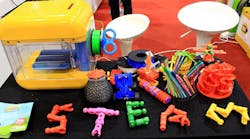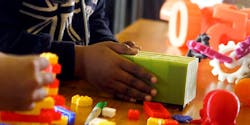Could a Chinese-made 3D printer get American children to excel at math and science again?
Much as Saudi Arabia knows its economy must someday transition away from oil, an unsustainable, resource, China knows that traditional manufacturing is becoming just as crude. According to reports, their answer is to imbue the next generation with the tools to create a new industrial base that’s focused on creation, not destruction: additive manufacturing.
The CEO of XYZprinting, the Taipei-based maker of the kid-friendly da Vinci Jr. 1.0 3D printer, has said the Chinese government wants to put a 3D printer in each of its 400,000 primary schools by next year, a move that could spur the inevitable 3D printing renaissance much sooner than previously expected.
No renaissance is complete without a Michelangelo to complement its da Vinci, and Shenzhen-based Weistek Co. believes it has found one with the MiniToy, a one-touch 3D printer that began development in February 2015. It is expected to be commercially available by Christmas. An already-funded Kickstarter is ongoing until June 24.
“We saw the market in China for education and executed quickly,” says Ken Kwok, Weistek’s vice president of marketing and sales, who notes that “the 3D printing industry has grown 100% in the last three years worldwide.”
The MiniToy 3D printer is safe and easy for children to use. Photo: Weistek Co.
Fourteen pounds lighter than the da Vinci Jr., the robust 19-lb box, meant for children ages five and older, has no sharp edges or external screws, and the raised printing tray hides the extruder from tiny, curious fingers. Adult supervision is still encouraged.
With a touch of a smart device (or PC), kids can create objects comprised of “fun” PLA materials that stretch, change color or glow in the dark, up to 170 x 130 x 150 mm. It takes anywhere from 30 to 60 min.
The smooth blue and yellow 3D printer looks equal parts Fisher-Price and Minion. It should easily capture the eye – and imagination – of any kid who uses it.
“Children don’t know it’s something industrial, they only know it’s cute and attractive and they want to touch it,” Kwok explains. “All the 3D printers, like MakerBot, 3D Systems and Ultimaker, they look fancy, but they are industrial.”
Along with design complexities not necessary for beginners, those can cost upwards of $1,000, while the MiniToy will retail for around $400-450, Kwok says. Kickstarter backers could still get the MiniToy for $299 per unit. Individual packages are almost sold out, but the campaign is still offering plenty of printers/filament bundles for schools or Duggar-sized families.
And even with toy in its name, this is at its core an educational tool. The company wants MiniToy to be THE go-to tool that every young child with an aptitude for science, technology, engineering, arts, and mathematics (STEAM). The library of shapes and objects is categorized by these subjects
“It’s a tool to explore,” Kwok says. “It helps children use their imagination to create a real object and help them develop mentally. Unlike playing with a block that they didn’t build, they get an understanding the dimensions and calculations, and see how the physical and mechanical work with each other.”
“We believe STEAM will be growing a lot, and there will be a lot of synergy with the MiniToy,” Kwok says. And just as the Harry Potter series grew more adult over time, Weistek expects MiniToy will evolve to meet the demands of the hungry minds who will want to build more and more complex objects.
“One thing we are working very hard to do is build cool 3D models. Assembly and expandable, make it more attractive for them to play and learn with,” he says.
MiniToy says it will grow with its users, offering more complex shapes and designs every year. They are currently looking for app partners.
Shenzhen, home base for Weistek, is 11 miles from Hong Kong, a region consistently ranked at or near No. 1 in children's math and science education global ranking . Giving their children a MiniToy is akin to giving Spartan children a mini gun. A less offensive comparison is gifting a 5-year old Michelangelo with Adobe InDesign.
The great thing about a renaissance, though, is that everyone has the opportunity to start fresh. Nothing is stopping an American school from buying a few low-priced 3D printers, whatever the brand, to inspire the next generation to be makers, not consumers.
During the robot revolution of the 1980s, Japan embraced the technology wholeheartedly while the U.S. gave it a limp-wristed handshake. China's is now pushing for 3D printing. If America doesn't shove back with equal aplomb, America's manufacturing class could be phased out even before fossil fuel.












